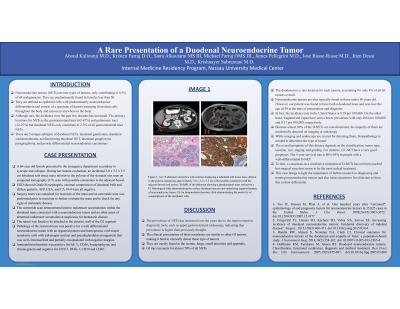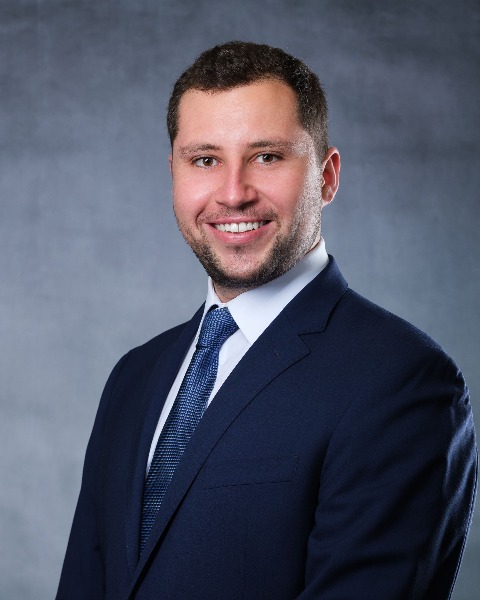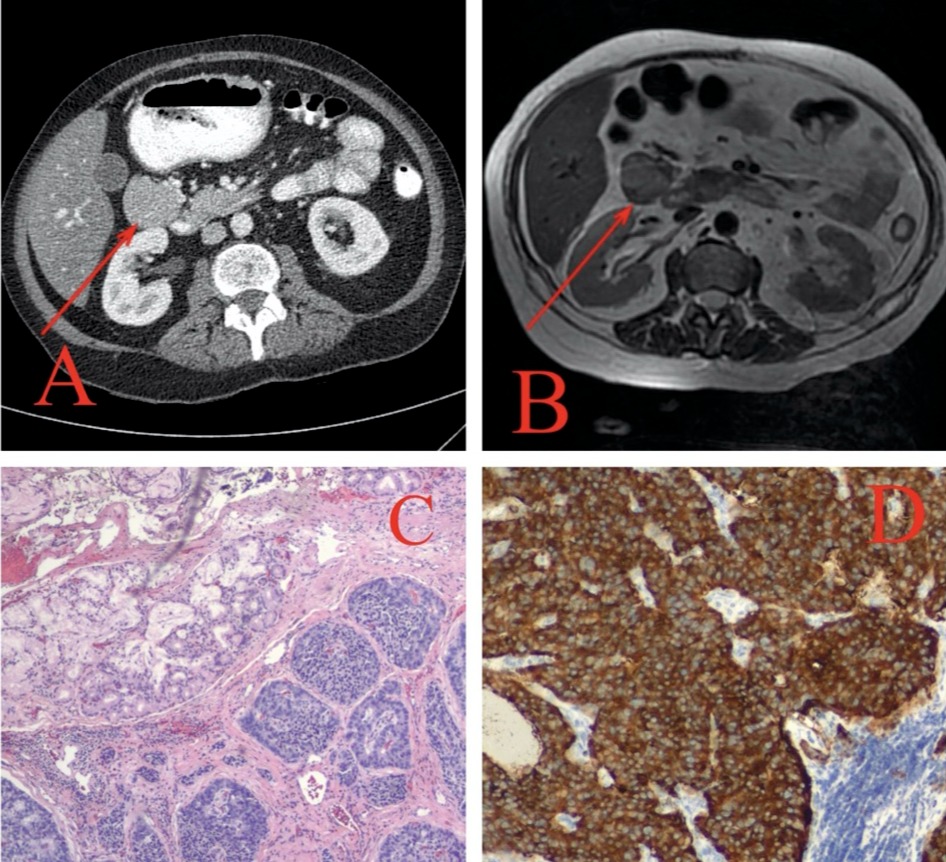Back


Poster Session E - Tuesday Afternoon
Category: Small Intestine
E0643 - A Rare Presentation of a Neuroendocrine Tumor
Tuesday, October 25, 2022
3:00 PM – 5:00 PM ET
Location: Crown Ballroom

Has Audio

Aboud Kaliounji, MD
SUNY Downstate Medical Center
Brooklyn, NY
Presenting Author(s)
Aboud Kaliounji, MD1, Kristen Farraj, DO2, Sami Alkoutami, BS3, Michael Farraj, BS4, James Pellegrini, MD2, Jose Russe-Russe, MD2, Jiten Desai, MD2, Deepthi Kagolanu, MD2, Kevin Yeroushalmi, MD2, Sandra Gomez-Paz, MD2, Krishnaiyer Subramani, MD2
1SUNY Downstate Medical Center, Brooklyn, NY; 2Nassau University Medical Center, East Meadow, NY; 3Nassau University Medical Center, Forest Hills, NY; 4Nassau University Medical Center, Yonkers, NY
Introduction: Neuroendocrine tumors (NETs) are rare types of tumors, only contributing to 0.5% of all malignancies. They are defined as epithelial cells with predominantly neuroendocrine differentiation and consist of a spectrum of tumors emerging from stem cells throughout the body and can occur anywhere in the body. While they are rare, the incidence over the past few decades has increased. The primary locations for NETs is the gastrointestinal tract (62-67%) and pulmonary tract (22-27%) but duodenal NETs only contribute to 2-3% of all gastrointestinal tract NETs. Here we present a case of a 64 year old female who was incidentally found to have a duodenal neuroendocrine tumor.
Case Description/Methods: A 64-year old female presented to the emergency department secondary to syncope and collapse. During her trauma evaluation, an incidental lobulated soft tissue mass inferior to the distal stomach was seen on complete computed tomography (CT) scans. The surgery team was consulted for resection of the mass and an octreotide scan was performed prior to resection to further evaluate the mass and to check for any signs of metastatic disease. The octreotide scan demonstrated intense radiotracer accumulation within the duodenal mass consistent with a neuroendocrine tumor and no areas of abnormal radiotracer accumulation suspicious for metastatic disease. Pathology of the resected mass was positive for a well differentiated neuroendocrine tumor with an organoid pattern and homogenous oval-round neoplastic cells with salt-pepper nuclear and pseudoglandular arrangement that was well circumscribed and partially encapsulated with negative margins. Immunohistochemistry was positive for AE ⅓, CD56, Synaptophysin, and chromogranin and negative for CD117, DOG-1, CD34 and CD45.
Discussion: The prevalence of NETs has increased over the years due to the improvement in diagnostic tools, such as upper gastrointestinal endoscopy. The duodenum is a rare location for such tumors, accounting only for 4% of all GI tumors overall. Neuroendocrine tumors are also typically found in those under 50 years old. However, our patient was found to have both a duodenal mass and was over the age of 50 at the time of presentation and diagnosis. To date, a consensus on a conclusive treatment of D-NETs has not been reached. This case brings to light the importance of further research in diagnosing and treating neuroendocrine tumors and also raises awareness for clinicians to have this in their differential.

Disclosures:
Aboud Kaliounji, MD1, Kristen Farraj, DO2, Sami Alkoutami, BS3, Michael Farraj, BS4, James Pellegrini, MD2, Jose Russe-Russe, MD2, Jiten Desai, MD2, Deepthi Kagolanu, MD2, Kevin Yeroushalmi, MD2, Sandra Gomez-Paz, MD2, Krishnaiyer Subramani, MD2. E0643 - A Rare Presentation of a Neuroendocrine Tumor, ACG 2022 Annual Scientific Meeting Abstracts. Charlotte, NC: American College of Gastroenterology.
1SUNY Downstate Medical Center, Brooklyn, NY; 2Nassau University Medical Center, East Meadow, NY; 3Nassau University Medical Center, Forest Hills, NY; 4Nassau University Medical Center, Yonkers, NY
Introduction: Neuroendocrine tumors (NETs) are rare types of tumors, only contributing to 0.5% of all malignancies. They are defined as epithelial cells with predominantly neuroendocrine differentiation and consist of a spectrum of tumors emerging from stem cells throughout the body and can occur anywhere in the body. While they are rare, the incidence over the past few decades has increased. The primary locations for NETs is the gastrointestinal tract (62-67%) and pulmonary tract (22-27%) but duodenal NETs only contribute to 2-3% of all gastrointestinal tract NETs. Here we present a case of a 64 year old female who was incidentally found to have a duodenal neuroendocrine tumor.
Case Description/Methods: A 64-year old female presented to the emergency department secondary to syncope and collapse. During her trauma evaluation, an incidental lobulated soft tissue mass inferior to the distal stomach was seen on complete computed tomography (CT) scans. The surgery team was consulted for resection of the mass and an octreotide scan was performed prior to resection to further evaluate the mass and to check for any signs of metastatic disease. The octreotide scan demonstrated intense radiotracer accumulation within the duodenal mass consistent with a neuroendocrine tumor and no areas of abnormal radiotracer accumulation suspicious for metastatic disease. Pathology of the resected mass was positive for a well differentiated neuroendocrine tumor with an organoid pattern and homogenous oval-round neoplastic cells with salt-pepper nuclear and pseudoglandular arrangement that was well circumscribed and partially encapsulated with negative margins. Immunohistochemistry was positive for AE ⅓, CD56, Synaptophysin, and chromogranin and negative for CD117, DOG-1, CD34 and CD45.
Discussion: The prevalence of NETs has increased over the years due to the improvement in diagnostic tools, such as upper gastrointestinal endoscopy. The duodenum is a rare location for such tumors, accounting only for 4% of all GI tumors overall. Neuroendocrine tumors are also typically found in those under 50 years old. However, our patient was found to have both a duodenal mass and was over the age of 50 at the time of presentation and diagnosis. To date, a consensus on a conclusive treatment of D-NETs has not been reached. This case brings to light the importance of further research in diagnosing and treating neuroendocrine tumors and also raises awareness for clinicians to have this in their differential.

Figure:
Figure 1: A) CT abdomen and pelvis with contrast displaying a lobulated soft tissue mass inferior to the pylorus measuring approximately 3.0 x 3.3 x 3.5 cm with possible connection with the adjacent bowel (red arrow). B) MRI of the abdomen showing a paraduodenal mass (red arrow). C) Histological slide demonstrating the surface duodenal mucosa and underlying organoid pattern of neuroendocrine tumor. D) An Immunohistochemistry slide demonstrating the positivity of synaptophysin of the neoplastic cells.
Figure 1: A) CT abdomen and pelvis with contrast displaying a lobulated soft tissue mass inferior to the pylorus measuring approximately 3.0 x 3.3 x 3.5 cm with possible connection with the adjacent bowel (red arrow). B) MRI of the abdomen showing a paraduodenal mass (red arrow). C) Histological slide demonstrating the surface duodenal mucosa and underlying organoid pattern of neuroendocrine tumor. D) An Immunohistochemistry slide demonstrating the positivity of synaptophysin of the neoplastic cells.
Disclosures:
Aboud Kaliounji indicated no relevant financial relationships.
Kristen Farraj indicated no relevant financial relationships.
Sami Alkoutami indicated no relevant financial relationships.
Michael Farraj indicated no relevant financial relationships.
James Pellegrini indicated no relevant financial relationships.
Jose Russe-Russe indicated no relevant financial relationships.
Jiten Desai indicated no relevant financial relationships.
Deepthi Kagolanu indicated no relevant financial relationships.
Kevin Yeroushalmi indicated no relevant financial relationships.
Sandra Gomez-Paz indicated no relevant financial relationships.
Krishnaiyer Subramani indicated no relevant financial relationships.
Aboud Kaliounji, MD1, Kristen Farraj, DO2, Sami Alkoutami, BS3, Michael Farraj, BS4, James Pellegrini, MD2, Jose Russe-Russe, MD2, Jiten Desai, MD2, Deepthi Kagolanu, MD2, Kevin Yeroushalmi, MD2, Sandra Gomez-Paz, MD2, Krishnaiyer Subramani, MD2. E0643 - A Rare Presentation of a Neuroendocrine Tumor, ACG 2022 Annual Scientific Meeting Abstracts. Charlotte, NC: American College of Gastroenterology.
